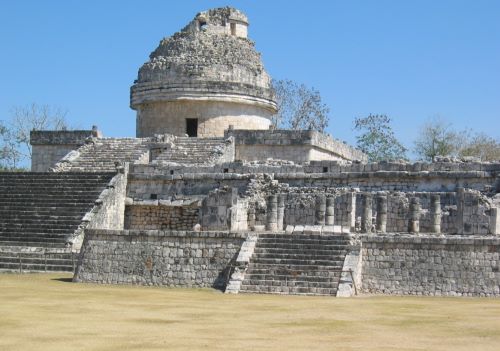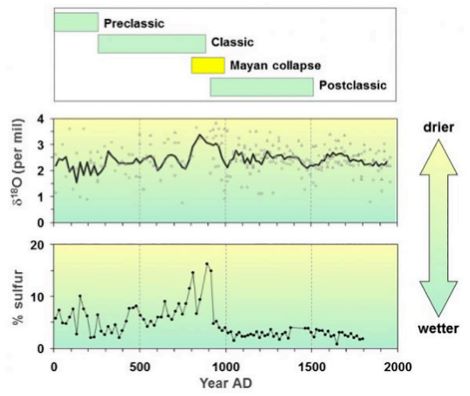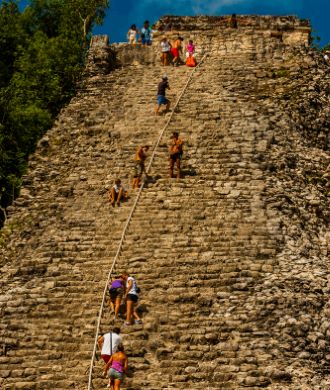

The cause of the collapse of the Classic Maya civilization is one of the great archaeological mysteries of our time.
Constructing thousands of architectural structures and developing sophisticated concepts in astronomy and mathematics, the Maya civilization rose to a cultural florescence between 600 and 800 CE. Then, between 800 and 950 CE, many southern cities were abandoned and most cultural activities ceased. This period is known by archaeologists as the collapse of the Classic Maya civilization. The Maya, never able to regain their cultural or geographical prominence, were assimilated into other Mesoamerican civilizations until the time of the Spanish Conquest in 1530 CE.
The cause of the collapse of the Classic Maya civilization is one of the great archaeological mysteries of our time, and scholars have debated it for nearly a century. Some scientists suggest that a period of intense drought occurred in conjunction with the Classic Maya collapse and could have contributed to the Mayans’ misfortune.

Scientists have reconstructed climate at the time of the Mayan civilization by studying lake sediment cores from the Yucatan Peninsula (Hodell et al. 1995; Curtis et al. 1996; Hodell et al. 2005). It is possible to reconstruct changes in the balance between precipitation and evaporation (P−E), a common indicator of drought, by measuring oxygen isotope data from the shells of gastropods and ostracods. Lake H2O molecules containing the isotope 18O evaporate less easily than H2O molecules with 16O. Thus, during periods of strong evaporation, the lake water becomes enriched in 18O (values of δ18O are high). These isotopic values are incorporated into the growing shells of gastropods and ostracods that live in the lake.
Another proxy for P−E is the percent of sulfur in the lake sediments. Evaporation concentrates sulfur in the lake water. If the sulfur concentration becomes high enough, salts such as gypsum (CaSO4) will start to precipitate from the lake water and add sulfur to the lake sediments. The variations of sulfur percentage match the variations in oxygen isotopes closely. Corroborating one paleoclimate proxy with another is an important check on proxy records and gives us more confidence in them.

Distinct peaks in these two proxies reflect times of aridity on the Yucatan Peninsula. The most arid time of the last 2,000 years occurred between 800 and 1000 CE, coincident with the collapse of the Classic Maya civilization. A newer high-resolution analysis of rainfall proxies from cave deposits in the Yucatan and in Belize indicates that multiple, decadal-scale severe droughts occurred during this interval (Medina-Elizalde et al. 2010; Kennett et al. 2012). Similar, though not necessarily synchronous, droughts appear to have happened in central Mexico as well (Stahle et al. 2011; Lachniet et al. 2012). These findings support a strong correlation between times of drought and a major cultural discontinuity in Classic Maya civilization. It is also important to remember that other factors such as overpopulation, deforestation, soil erosion, and disease could have contributed to the demise of the Mayans.
Some important datasets related to drought and the collapse of the Mayan civilization:
- Hodell et al. (1995), sediment geochemistry data from Lake Chichancanab, Mexico
- Curtis et al. (1996), sediment data from Punta Laguna, Mexico
- Hodell et al. (2005), high-resolution sediment data from Lake Chichancanab, Mexico
- Medina-Elizalde et al. (2010), speleothem record from Tzabnah Cave, Mexico
- Stahle et al. (2011), tree ring records of Mesoamerica
- Kennett et al. (2012), speleothem record from Yok Balom Cave, Belize
- Lachniet et al. (2012), speleothem record from Juxtlahuaca Cave, Mexico
Originally published by the National Oceanic and Atmospheric Administration (NOAA), U.S. Department of Commerce, October 2021, to the public domain.


